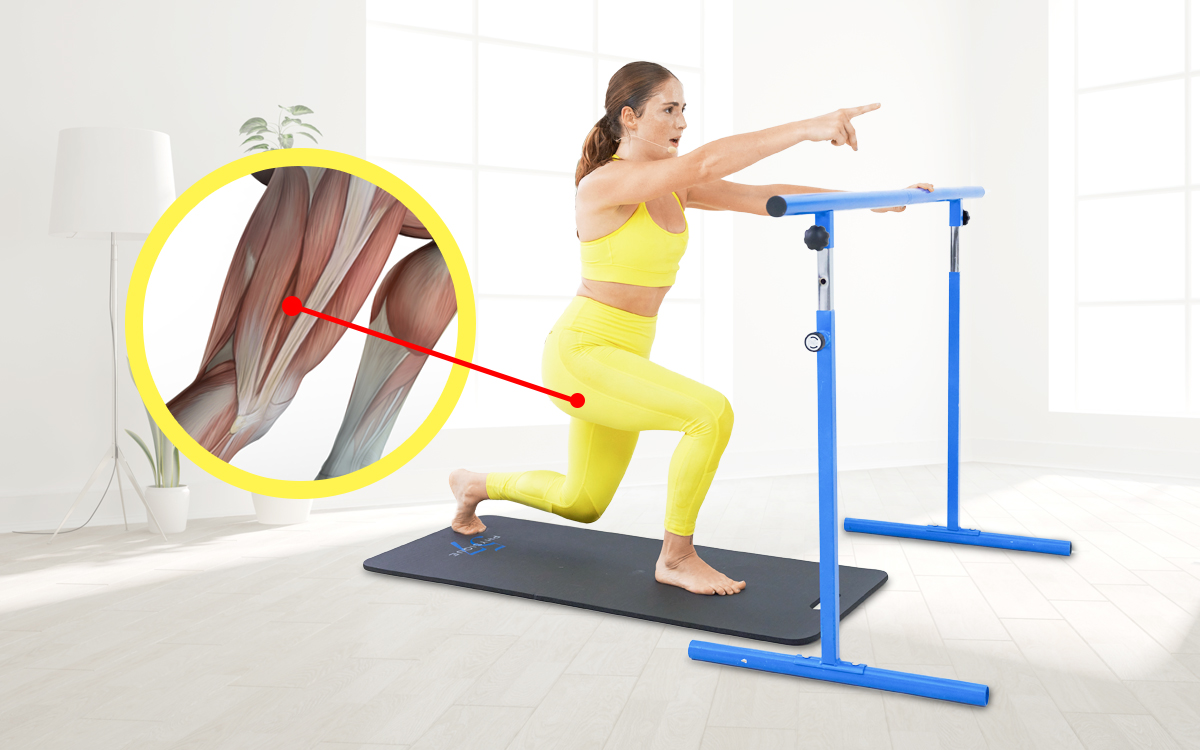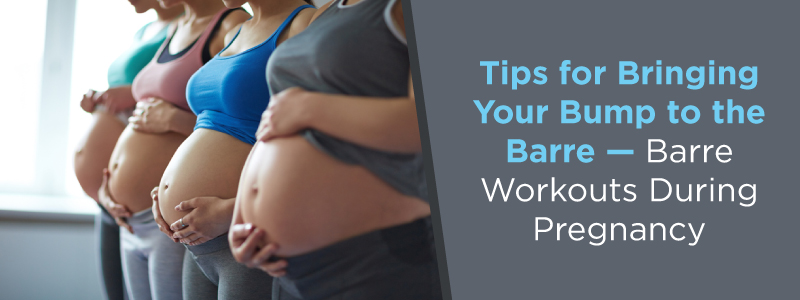
Looking for a way to keep your body strong and fit as your bump grows? Barre is the perfect fit. Because it’s low-impact, controlled and focused, Physique 57 is perfectly suited to pregnancy. It’s easily adaptable to work with your growing bump. Our program is safe and effective, and it prepares you both mentally and physically for labor and delivery.
Follow our bump-friendly tips for barre workouts during pregnancy so that you can get the most out of your classes. You’ll gain an extra boost of strength and confidence to carry you through your pregnancy.
Listen to Your Body
You know your body better than anyone, but when you’re pregnant, what feels normal can change — even from one day to the next. That’s why it’s so important to listen to the signs your body gives you, whether you’re at barre class or going about your normal daily routine.
In barre class, you want to be careful not to overdo anything. Physique 57 classes are non-competitive, so you don’t have to worry about keeping up with anyone else. We encourage you to do what feels good for your body on any given day. Always talk to your doctor before starting a new exercise program, especially if you’re pregnant. If you were already taking barre classes before your pregnancy, it’s still a good idea to touch base with your doctor to check for any restrictions.
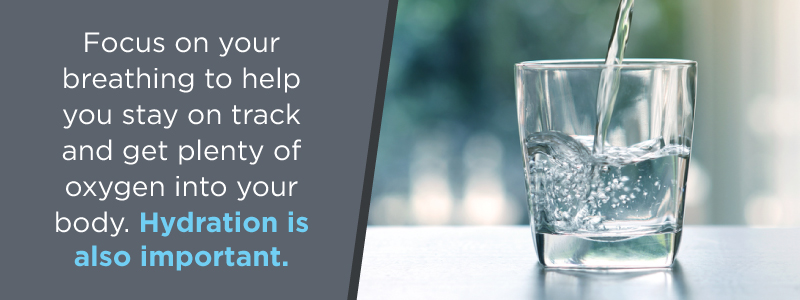
While exercising, always move with control and care to keep your body safe. Focus on your breathing to help you stay on track and get plenty of oxygen into your body. Hydration is also important.
- Pacing is an important part of listening to your body. Some days, you may feel like you can push yourself as you did in your pre-bump days. On those days, let yourself go, and enjoy the surge of strength and power. Other times, you may feel like everything you do takes more energy.
- Give yourself permission to slow down, make more modifications and do what’s right for your body. Even if you don’t finish every set or do a certain version of a move, you’re still showing up and working to make your baby bump — and the rest of your body — strong and fit.
- Focus on your pacing one day at a time. Don’t worry about what you did yesterday or last week. Your energy level will likely change throughout your pregnancy. Many expectant moms feel extreme exhaustion during the first trimester due to the hormonal changes going on in their bodies.
- As you near the second trimester, you might feel your energy coming back. Your bump isn’t huge yet, so you can still move around easily. The closer you get to your due date, the more you might notice yourself slowing down again. Your growing bump might require you to make modifications or slow your pace.
- Keeping your heart rate at a reasonable level is crucial. If you exercised before your pregnancy and don’t have any complications associated with your pregnancy, you shouldn’t need to limit your heart rate to a certain number of beats per minute. Check your pacing by trying to carry on a conversation. If you can have a conversation with someone, your pace is fine. If you’re pushing yourself so hard that you can’t speak, it’s probably time to slow it down a little.
Another aspect of listening to your body is knowing when something doesn’t feel right. You know the normal burn you feel from a good barre workout. That’s different than a twinge or even a more intense pain that tells you something’s not right. If you notice any unusual symptoms or pains, don’t ignore them. You might need to slow down your pace or end your workout early. Always talk to your doctor if you experience anything unusual or concerning.
Target the Right Muscle Groups
It’s always a good idea to work out your entire body, but pregnancy puts more emphasis on certain muscle groups. Specifically, you want to target your glutes, inner thighs, hamstrings, abdominals, pelvic floor and upper and lower back. Why? Focusing on those areas helps you lengthen and strengthen the muscles that best help you accommodate your growing bump — you’re making room for your growing baby. It can also help you feel stronger in your ever-changing body.
Certain muscles play a specific role in the process as well. Glutes support your hips and help protect your lower back. Weak glutes can cause other muscles to compensate, which can lead to lower back pain. Strong abs support your growing belly and help you push more effectively when you’re in labor. Back muscles are critical to support your growing tummy and the shifting center of gravity. When you keep your back muscles strong, you can stand up straight and tall instead of slumping as your bump grows.
Do the Right Kind of Ab Work and Keep Up With Your Kegels
Core strength is so important during your pregnancy. It helps your body adapt to the constant postural changes during pregnancy, so it’s important to continue your ab work. It’s all about finding the right balance. You want a flexible belly that grows with your baby, but it also needs to be strong enough to support that growth. The good news? Your abdominals get a workout through most of your Physique 57 workout, from deep abdominal stabilization to focused exercises.
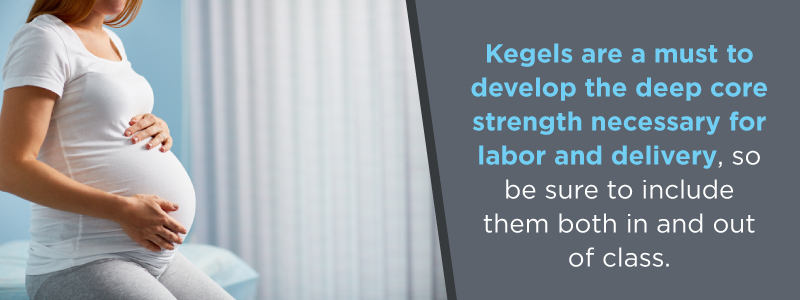
Kegels are a must to develop the deep core strength necessary for labor and delivery, so be sure to include them both in and out of class. Kegel exercises focus on the muscles that support your bladder, bowels and uterus. Those muscles come in handy during labor and delivery. Kegels also help speed up your recovery after delivery, including increasing your urinary control.
Not sure how to do Kegels? Pretend like you want to stop the flow of urine. Squeeze those same muscles, and you’re doing Kegels. If you do them correctly, no one will know you’re doing them because your legs, abs and glutes shouldn’t move.
Learn Barre Modifications for Pregnancy
In the early stages of your pregnancy, you probably won’t need any modifications. You may need to slow down a bit because of the exhaustion, but your body will likely still do all the things it normally does. By around 20 weeks, you’ll probably need to start modifying. That’s when changes to your body can begin affecting exercise.
Your uterus becomes larger and heavier, which can put more strain on other parts of your body. Standing without moving for long periods or lying on your back for longer than a few minutes can be dangerous. They can slow down the return of blood to your heart, which can cause a temporary decrease in blood pressure.
Supporting your back or working in a more upright position can relieve that pressure and let you exercise safely. Lying on your stomach is another position that isn’t recommended for pregnancy. It puts too much pressure on your uterus, and it becomes quite difficult as your belly grows. Working on all fours for exercises that normally take place while lying on your stomach is an alternative.
Some other physical changes that can push you toward making modifications include:
- Stretching and relaxation of the ligaments that support your joints, which can increase the risk of injury with high-impact or jerky movements
- Increased need for oxygen and energy, which can make you short of breath faster
- Pressure on your diaphragm from your growing uterus, which can make you short of breath
- Changing center of gravity that changes your balance and decreases your stability
Keeping those factors in mind in barre class can help you self-monitor your intensity and make small adjustments. You should also be aware of specific modifications based on physical changes. Your barre instructor can give you personalized instruction on how to modify different moves to ensure you and your baby stay safe and healthy.
The following modifications for barre classes while pregnant give you an idea of what to expect.
1. Stretches
The relaxing ligaments in your joints may make stretching feel a little easier. It can make you seem a little more flexible than normal. Just be careful not to push your stretching too far — you don’t want to hurt yourself by stretching beyond a safe and normal range of motion.
Certain types of stretches are also best left for your pre-bump and early pregnancy days. Once you reach 20 weeks, it’s best to avoid any stretches that have you twist from the waist. If you make twisting moves, make them small rather than deep twists.
2. Seat Exercises
Your growing uterus becomes heavier and puts more weight on your body over time. That change can mean more strain on your back that causes discomfort. When working on your glutes, it’s a good idea to modify to make sure your back stays upright or on a diagonal to ease any strain and discomfort on the back. It can also make your glute workout more effective while keeping your back safe.
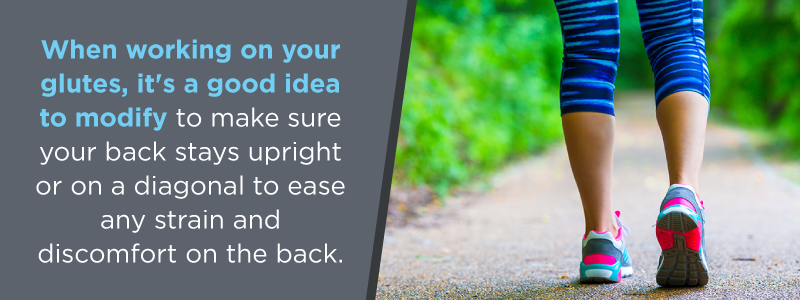
Notice how your back feels as you do your seat work. If you feel too much strain on your lower back, keep your chest up. You can stand at the bar while doing this, keeping with the same choreography, just with your chest up.
Using a smaller range of motion may also be necessary during seat work. Doing so helps you avoid injury with your looser joints. You can also widen your knees as your bump grows to make room for it during different seat work exercises.
3. Risers for Back Support
Risers positioned under your regular mat during round back and abdominal work provide support for your back. They also help tilt your pelvis forward to maintain good blood flow. If you don’t use the risers, your uterus can press down on your vena cava and slow your blood flow significantly. You may also notice cramping in your uterus and calves without the proper support from risers.
4. Abdominal Exercises
It may seem like you should avoid working your abs during pregnancy, but it’s actually more important than ever to strengthen those muscles. Strong abdominal muscles support your growing uterus and help you during childbirth and recovery. Pay special attention to your positioning, keeping your feet down and ensuring your pelvis stays tilted properly. Like with any other move, it’s important to listen to your body to make sure you don’t overdo your ab workout.
You might find that instead of moving, you need to simply hold the position. Don’t worry so much about choreography for your legs. Your obliques should go in and down while your lower abs go up and in. This movement helps strengthen the muscles in the way you’ll use them for labor. You’re still strengthening your abs and working on your breathing, so you’re getting the workout you need on your terms. Holding on behind your legs when working on your abs can also help.
In round back, you may need to adjust your height to get an ideal position, depending on where your baby is within your abdomen. A little adjustment can improve how well you can squeeze and feel your abs during this exercise. You may also want to keep a foot planted during this exercise, with your hand lightly gripping the leg that’s working. Lowering your leg a little bit helps accommodate your growing tummy.
5. Keep Your Head Above Your Heart
A good rule of thumb throughout pregnancy, not just in barre class, is to keep your head above your heart. Your blood volume increases by up to 50 percent during pregnancy. That extra blood means your heart has to work harder to keep it pumping.
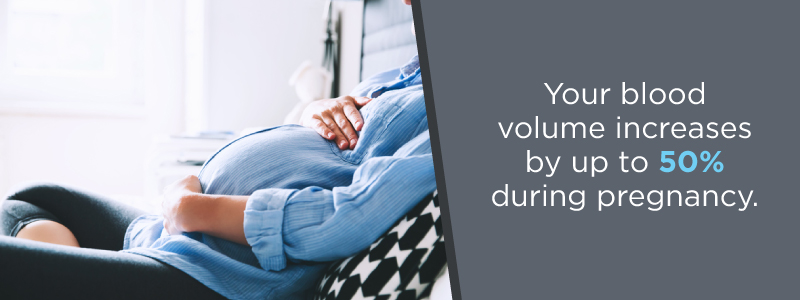
Keeping your head above your heart improves circulation and makes less work for your heart, so it beats at a reasonable rate. You can enjoy your workout without making your heart beat faster than is necessary or safe. Prenatal wedges for all back and side-lying exercises help you keep this ideal pregnancy position. The wedges give you support and make you more comfortable as you do each move.
Have Fun and Reap the Benefits
Your growing bump comes with a growing list of things to worry about and plan. Barre class is your chance to disconnect and do something for yourself. It’s just a small part of your day when you can focus on yourself, but the rewards you reap are plentiful — mentally, physically and emotionally. Take this time to focus on your breath and prepare mentally for the changes coming into your life.
Pregnant women often hear what they shouldn’t do. Well-meaning people tell you to take it easy, stop working out and focus only on the baby. You rarely hear what you should do. Barre class is your chance to silence the “shouldn’t do’s” in favor of more positive sentiments. It’s refreshing to focus on the positive and know that it’s okay and important to enjoy yourself while doing it. After all, pregnancy can be an extremely busy time, so dedicating even an hour to your health, fitness and well-being is already something to celebrate.
Benefits of Exercise During Pregnancy
Our expectant clients experience a variety of benefits from our classes, including improved posture, decreased lower back pain, increased pelvic stability and even better sleep. Not to mention that sexy, sculpted muscles are the perfect accessory to go along with radiantly glowing skin, luxurious hair and that baby bump you’re rocking. It turns out, exercise offers many benefits for pregnant women. As long as you get your doctor’s approval, exercise is something you definitely want to incorporate into your daily routine.
The benefits of exercising during pregnancy include:
- Smaller weight gain to help you stay within the healthy recommended range
- As much as a 27 percent decrease in risk for gestational diabetes
- Decreased back pain
- Increased stamina and strength for labor and delivery
- Higher energy levels
- Improvement in your mood
- Better posture
- Improved sleep
- Lower risk of constipation, which is common due to increased progesterone levels and your growing uterus
- Enhanced view of your pregnant body and increased confidence
- Greater relaxation and lower stress levels
- Decreased leg swelling
- Faster recovery after delivery
- Continued exercise routine instead of falling out of the habit of being active
When you come to barre class to reap those benefits, you get the bonus of having a built-in community where you’re truly part of something special. You may even meet other expectant moms in barre class, so you can share your experiences and build a friendship that lasts even after you give birth.
Keep these tips in mind the next time you bring your bump to the barre. Join one of our studio classes that offer modifications for our prenatal clients at our New York City location. If you’re not in the area, don’t worry — try our online workouts especially our pre/postnatal workout collection!



